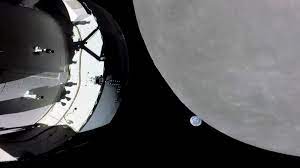NASA’s Artemis 1 mission’s Orion spacecraft broke a record set by the Apollo 13 mission in 1970. Read about that and more in our weekly space news recap.

After finishing its close encounter with the Moon, NASA’s Orion spacecraft broke the record for the farthest distance from Earth travelled by a human-rated spacecraft. This record was previously held by the Apollo 13 spacecraft with travelled 248,655 miles away from Earth. Read about NASA’s Artemis 1 milestone and more in our weekly space news recap.
Artemis 1 surpasses Apollo 13 record
On Saturday, November 26, NASA’s Artemis 1 mission’s Orion spacecraft broke the record for the farthest distance travelled away from Earth by a spacecraft designed for humans. The previous record was held by the Apollo 13 mission when the Apollo spacecraft went 258,655 miles away from our planet. At its farthest from the Moon, the Orion spacecraft will be more than 270,000 miles away from our planet.
Orion entered a “distant retrograde orbit” on Friday, November 25 and will continue to remain in this orbit for five more days before exiting the lunar orbit to put itself on a trajectory back to Earth for a planned splashdown in the Pacific Ocean on Sunday, December 11.
Venusian volcanism
Venus’s volcanism may have played a major role in changing the planet’s once wet and temperate climate to the raging heat that we know it for today. According to new research, large-scale volcanism that lasted tens or hundreds of thousands of years may have spewed around 100,000 cubic miles of rock on the surface.
The massive volcanic eruptions may have set the ball rolling for Venus’s current climate, with surface temperatures averaging around 460 degrees celsius and surface pressure that is a whopping 90 times that on Earth. The many volcanic eruptions that could have happened on Venus could have caused a runaway greenhouse effect that could have catalysed the transition of the planet from a wet and temperature one to a scorching dry one.

ISRO launches PSLV
The Indian Space Research Organisation’s PSLV launch vehicle launched on its 56th flight, successfully placing multiple satellites into sun-synchronous orbits, including an Earth Observation satellite and eight others. ISRO chief S Somanath called the mission “unique” and said that agency scientists used two orbit change thrusters to change its orbit for the first time.
The Earth Observation Satellite, which was the primary payload, was built by ISRO for departments and ministries in the Indian government. One of the satellites was built as part of a collaboration between India and Bhutan.

